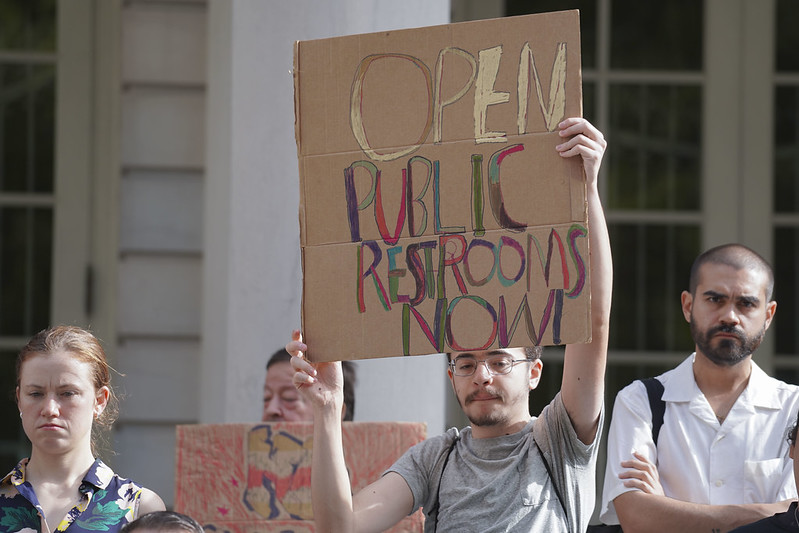“The lack of public bathrooms is one of the daunting challenges and cruel indignities that unsheltered New Yorkers consistently face as they draw on meager resources to survive life on the streets.”

Gerardo Romo / NYC Council Media Unit.
A September rally calling for the city to open more public bathrooms.Thirty-four years ago, a group of homeless New Yorkers filed a class-action lawsuit against the city for its failure to provide public bathrooms, citing the continual humiliation and hazards that they were forced to endure because of the lack of bathrooms. Decades later, we still suffer because the city has made little progress in ensuring that all New Yorkers can take care of their basic bodily needs.
As a formerly homeless person living with Crohn’s disease, Will lived in shelters at a time when residents were forced to leave their dorms during the day. Because of this, he didn’t have access to a bathroom and, due to EBT restrictions, couldn’t always purchase an item from a business in exchange for restroom use.
Many people with health conditions like Will are unable to make it to a bathroom in time and are often betrayed by their bodies. Will continuously suffered the embarrassment of explaining to supervisors why he would be late or miss a shift because of a “wardrobe malfunction.” No one should have to experience that kind of indignity—not when there can and should be acceptable options.
As a retired Wall St. worker, Nathylin Flowers spent five years in the shelter system. During the day, she had to leave the shelter at 7:30 a.m. and was only allowed to return at 5 p.m. Too often, Ms. Flowers would run to find a dark spot between parked cars and prayed no one would see, as she dropped and squatted whenever she had to pee. Ms. Flowers planned her trips to doctor’s offices, visits to family and friends, and interviews for jobs and housing around available public bathrooms in the MTA.
When the subways closed during the pandemic, having to go became a frightful experience, often requiring her to exit the subway and disrupt her travel in search of a nearby bathroom. As a leader of VOCAL-NY, Ms. Flowers was proud to pick up the fight started by Picture the Homeless in 2018, continuing the call for public accommodations throughout New York City via our Free to Pee Campaign.
The lack of public bathrooms is one of the daunting challenges and cruel indignities that unsheltered New Yorkers consistently face as they draw on meager resources to survive life on the streets. According to a report by the Coalition for the Homeless, the lack of public bathrooms was a frequent theme in surveys and interviews of 200 unhoused people.
Not only is this an issue for homeless individuals, but New Yorkers from all walks of life. From disabled people who struggle to find bathrooms that are accessible to those who menstruate, have health conditions, are pregnant, seniors, children, and tourists—everyone has to contend with the lack of bathrooms in a way that limits their ability to navigate the city and go about daily business.
With only one restroom for every 7,500 residents, New York City ranks 93rd out of the 100 largest U.S. cities in the number of public bathrooms per capita. Only two public bathrooms are open 24 hours a day, 7 days a week. In fact, the largest source of public bathrooms are in parks, which are only open from 8 a.m. to 4 p.m. In addition, a recent survey by the City Council found that two-thirds of Parks Department bathrooms inspected had significant issues, including closures during scheduled hours, or lacked functional locks, soap, or other supplies.
And what happens when people can’t hold it any longer? They are forced to urinate or defecate in public and face criminalization. In just the past fiscal year, NYPD summonses for public urination increased by 46 percent. Despite the city’s lack of progress in providing New Yorkers with accessible public restrooms, we are criminalizing people for having to go.
Some people might recommend walking into a business to use their restroom. But, making a purchase to use the bathroom is not an affordable option for the 2 million New Yorkers living in poverty. The 2018 arrests of two Black men in Philadelphia requesting to use a Starbucks bathroom highlights the racial dimension to bathroom access. Requesting private bathroom access is risky for Black people, just as much as it is for people who are perceived to be homeless.
New York City must treat people with compassion, and provide relief to all who need to go. Championed by Councilmembers Rita Joseph and Sandy Nurse, the City Council is considering three bills that would require municipal office buildings that are already open to the public to make their bathrooms available to all; create a capital plan and timeline for installing more public bathrooms in parks and subway stations that have already been identified as suitable locations; and generate a 10-year plan to reach a ratio of one bathroom for every 2,000 residents through a range of options, including public-private partnerships, automated freestanding toilets, and incentives to businesses to be part of a public bathroom network.
The City Council and mayor must prioritize passing and enacting this “Free to Pee” package of bills. This is not just a matter of convenience; it’s about improving our city’s quality of life, public health, human dignity, and equity for all.
How long must we wait for relief?
Will Woods is a member education & programming specialist at Open Hearts Initiative, Nathylin Flowers Adesegun is a leader with VOCAL-NY’s Homelessness Union, and Alison Wilkey is the director of government affairs and strategic campaigns at the Coalition for the Homeless.








